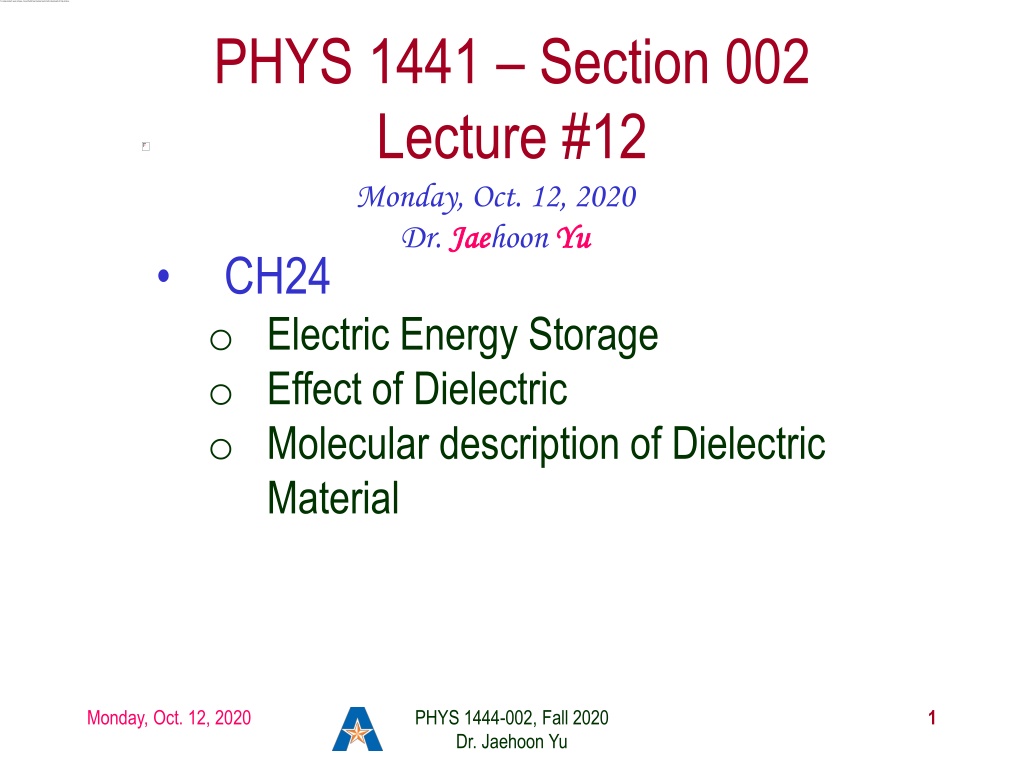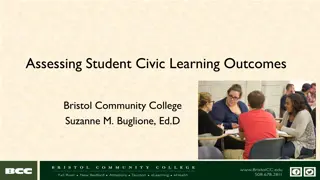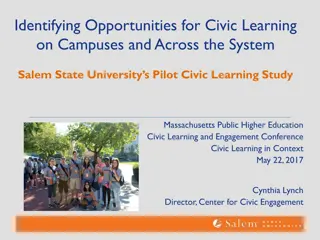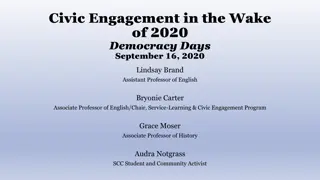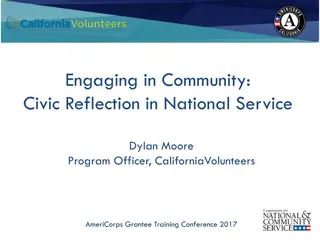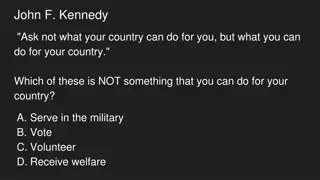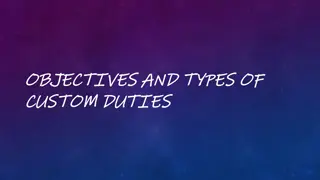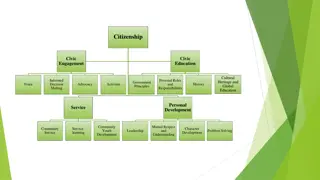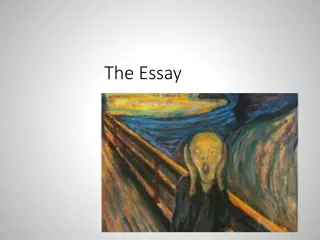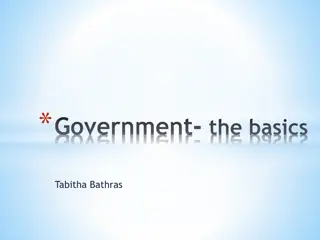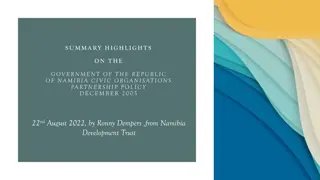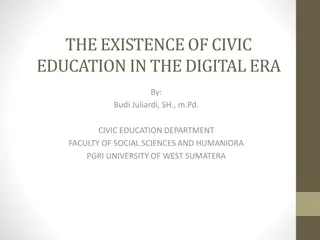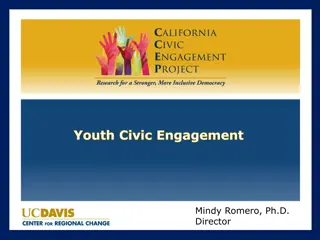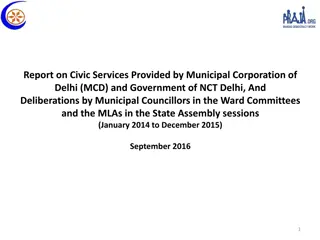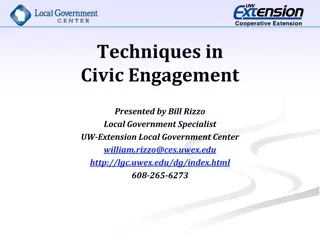PHYS 1444-002 Fall 2020: Important Updates and Civic Duties
Stay informed about upcoming events in your PHYS 1444-002 course with Dr. Jaehoon Yu this fall! Get ready for the online mid-term exam, a special seminar on COVID-19, and take part in civic duties by registering to vote and participating in the election. Earn extra credit while staying engaged and involved in current affairs. Deadlines and instructions provided for each activity. Stay connected and make a difference!
Download Presentation

Please find below an Image/Link to download the presentation.
The content on the website is provided AS IS for your information and personal use only. It may not be sold, licensed, or shared on other websites without obtaining consent from the author. Download presentation by click this link. If you encounter any issues during the download, it is possible that the publisher has removed the file from their server.
E N D
Presentation Transcript
PHYS 1441 Section 002 Lecture #12 Monday, Oct. 12, 2020 Dr. Jae Jaehoon Yu CH24 o Electric Energy Storage o Effect of Dielectric o Molecular description of Dielectric Material Yu Monday, Oct. 12, 2020 PHYS 1444-002, Fall 2020 Dr. Jaehoon Yu 1
Announcements Online Mid-term comprehensive exam on Quest In class Monday, Oct. 19 Covers: CH21.1 through what we finish Wednesday, Oct. 14 + math refresher BYOF: You may bring a one 8.5x11.5 sheet (front and back) of handwritten formulae and values of constants for the exam No derivations, word definitions, setups or solutions of any problems, figures, pictures, diagrams or arrows, etc! No additional formulae or values of constants will be provided! Must send me the photos of front and back of the formula sheet, including the blank, no later than 11am the day of the exam Once submitted, you cannot change, unless I ask you to delete some part of the sheet! Quiz 2 results Class average: 35.5/60 equivalent to 58.8/100 (Q1: 80.3/100) Top score: 60/60 Special seminar on COVID 19: 3:30pm Sunday, Oct. 25 Dr. Linda Lee Extra credit for participating in the seminar and asking a relevant question Monday, Oct. 12, 2020 PHYS 1444-002, Fall 2020 Dr. Jaehoon Yu 2
Reminder: SP#3 Civic Duty I: Voter Registration Voter registration in Texas ends on Monday, Oct. 5, 2020 Registration can be done: https://www.votetexas.gov/register/index.html Check your registration: https://teamrv-mvp.sos.texas.gov/MVP/mvp.do For those who are legal to take part in the election Your own registration to vote: 10 points Include the screen shot your own voter registration check You can have up to 3 more people who are not registered to register: 5 points each Must include before and after the registration screen shots of the same person next to each other to show these are newly registered For those who are not legal to take part in the election You can have up to 5 people who are not registered to register: 5 points each Must include before and after the registration screen shots of the same person next to each other to show these are newly registered Deadline: 1pm Wednesday, Oct. 14, 2020 Put all screen shots in one pdf file following the naming convention SP3- LastName-FirstName-Fall20.pdf and upload to the CANVAS assignment Monday, Oct. 12, 2020 PHYS 1444-002, Fall 2020 Dr. Jaehoon Yu Note extended deadline 3
SP#3 Civic Duty I: Voter Registration 2 Monday, Oct. 12, 2020 PHYS 1444-002, Fall 2020 Dr. Jaehoon Yu 4
SP#5 Civic Duty II: Election Participation Election on Nov. 3 with early voting Tue. Oct. 13 Fri. Oct. 30 For those with legal voting rights: You can submit three access code green sheet for 20 points total one your own and two others who voted, 5 points each. Any additional ones will earn 2 points each For those without legal voting rights: You can submit for the first four access code green sheets for 20 points total, 5 points each and any additional combinations 2 points each. Be sure to tape one side of the stickers on a sheet of paper with your name on it. Write the full name of the person next to the corresponding access code sheet None of the stickers can be from the same person on someone else s extra credit or on your own. All of those with any of the identical persons on your extra credit sheet will get 0 credit. Deadline: Beginning of the class Monday, Nov. 9 Monday, Oct. 12, 2020 PHYS 1444-002, Fall 2020 Dr. Jaehoon Yu 5
Access code sheet Monday, Oct. 12, 2020 PHYS 1444-002, Fall 2020 Dr. Jaehoon Yu 6
Recap: Capacitor Combinations Capacitance Series Combinations Qd e0A=e0A C =Q Q = Vba d 1 1 1 1 = + + C C C C 1 2 3 eq Parallel Combinations = + + C C C C 1 2 3 eq Monday, Oct. 12, 2020 PHYS 1444-002, Fall 2020 Dr. Jaehoon Yu 7
Example 24 5 Equivalent Capacitor: Determine the capacitance of a single capacitor that will have the same effect as the combination shown in the figure. Take C1=C2=C3=C. We should do these first!! How? These are in parallel so the equivalent capacitance is: C = 1 2 C C + = 2C 1 eq Now the equivalent capacitor is in series with C1. 1 C 1 2 eq C C 2C 1 1 =1 1 C =3 2C 2 C = + + = C Solve for Ceq eq 3 eq Monday, Oct. 12, 2020 PHYS 1444-002, Fall 2020 Dr. Jaehoon Yu 8
Electric Energy Storage A charged capacitor stores energy. The stored energy is the amount of the work done to charge it. The net effect of charging a capacitor is removing one type of charge from one plate and putting them on to the other. Battery does this when it is connected to a capacitor. Capacitors do not get charged immediately. Initially when the capacitor is uncharged, no work is necessary to move the first bit of charge. Why? Since there is no charge, there is no field that the external work needs to overcome. When some charge is on each plate, it requires work to add more charge due to the electric repulsion. Monday, Oct. 12, 2020 PHYS 1444-002, Fall 2020 Dr. Jaehoon Yu 9
Electric Energy Storage The work needed to add a small amount of charge, dq, when a potential difference across the plates is V: dW=Vdq. Since V=q/C, the work needed to store total charge Q is C 2 1 Q Q Q W = = = qdq V dq 2 C 0 0 Thus, the energy stored in a capacitor when the capacitor carries the charges +Q and Q is 2 Q = U 2 C Since Q=CV, we can rewrite 2 1 2CV =1 Q 2 U = C= 2QV 2 Monday, Oct. 12, 2020 PHYS 1444-002, Fall 2020 Dr. Jaehoon Yu 10
Example 24 8 Energy store in a capacitor: A camera flash unit stores energy in a 150 F capacitor at 200V. How much electric energy can be stored? Using the formula for stored energy. Umm.. Which one? C and V What do we know from the problem? 1 2 So we use the one with C and V: 2 = )( U CV ( 1 2 1150 10 2 ) 2 2 6 = = = 200 3.0 U CV F V J = C V J C CV = 2 FV = 2 = How do we get J from FV2? J V C Monday, Oct. 12, 2020 PHYS 1444-002, Fall 2020 Dr. Jaehoon Yu 11
Electric Energy Density The energy stored in a capacitor can be considered as being stored in the electric field between the two plates For a uniform field E between two plates, V=Ed and C= 0A/d Thus the stored energy is 1 2CV = 2 d A 1 2 1 ( ) 2 2 2 0 U = = E Ad Ed 0 Since Ad energy density, stored energy per unit volume, as 1 2 Adis the gap volume V, we can obtain the Valid for any space that is vacuum 2 = u E 0 Monday, Oct. 12, 2020 Electric energy stored per unit volume in any region of space is proportional to the square of E in that region. PHYS 1444-002, Fall 2020 Dr. Jaehoon Yu 12
Dielectrics Capacitors have an insulating sheet of material, called the dielectric, between the plates to Increase breakdown voltage greater than that in air (3MV/m) Apply higher voltage to the gap without the charge passing across Allow the plates get closer together without touching Increases capacitance ( recall C= 0A/d) Increase the capacitance by the dielectric constant C KC = 0 Where C0 is the intrinsic capacitance when the gap is vacuum Monday, Oct. 12, 2020 PHYS 1444-002, Fall 2020 Dr. Jaehoon Yu 13
Dielectrics The value of dielectric constant K varies depending on the material (Table 24 1) K for vacuum is 1.0000 K for air is 1.0006 (this is why the permittivity of air and vacuum are used interchangeably.) K for paper is 3.7 Maximum electric field before breakdown occurs is called the dielectric strength. What is its unit? (poll3) V/m The capacitance of a parallel plate capacitor with a dielectric (K) filling the gap is A d = = C KC K 0 0 Monday, Oct. 12, 2020 PHYS 1444-002, Fall 2020 Dr. Jaehoon Yu 14
Dielectrics A new quantity of the permittivity of a dielectric material is defined as =K 0 The capacitance of a parallel plate capacitor with a dielectric medium filling the gap is A d = C The energy density stored in an electric field E in a dielectric is 1 2 1 2 Valid for any space w/ dielectric w/ permittivity . 2 2 = = u K E E 0 What is the stored energy in between ProtoDUNE cathode (-300kV) plate (6mx6m) and the cryostat wall (0V), d=1.5m, LAr K=1.5? Monday, Oct. 12, 2020 PHYS 1444-002, Fall 2020 Dr. Jaehoon Yu 15
ProtoDUNE Dual Phase Calculate the capacitance between each of the side wall to the FC & the cathode to the ground grid Calculate the total energy stored in the capacitors LAr =1.4 0 Charge Readout Planes 6 m Field Cage (common structural elements with SP) 1 m Cathode 0.75 m 6 m Monday, Oct. 12, 2020 PHYS 1444-002, Fall 2020 Dr. Jaehoon Yu 16
Effect of a Dielectric Material on Capacitance Let s consider the two cases below: Case #1 : constant V Case #2 : constant Q Constant voltage: Experimentally observed that the total charge on each plate of the capacitor increases by K as a dielectric material is inserted between the gap Q=KQ0 The capacitance increased to C=Q/V0=KQ0/V0=KC0 Constant charge: Voltage found to drop by a factor K V=V0/K The capacitance increased to C=Q0/V=KQ0/V0=KC0 Monday, Oct. 12, 2020 PHYS 1444-002, Fall 2020 Dr. Jaehoon Yu 17
Effect of a Dielectric Material on Field What happens to the electric field within a dielectric? Without a dielectric, the field is What are V0 and d? V0: Potential difference between the two plates d: separation between the two plates For the constant voltage, the electric field remains the same For the constant charge: the voltage drops to V=V0/K, thus the field in the dielectric is The field in the dielectric is reduced. E E = V d 0 = E 0 V dK E K V d 0 0 = = = = E E D 0 Monday, Oct. 12, 2020 PHYS 1444-002, Fall 2020 Dr. Jaehoon Yu K 18 D
Example 24 11 Dielectric Removal: A parallel-plate capacitor, filled with the dielectric of K=3.4, is connected to a 100-V battery. After the capacitor is fully charged, the battery is disconnected. The plates have area A=4.0m2, and are separated by d=4.0mm. (a) Find the capacitance, the charge on the capacitor, the electric field strength, and the energy stored in the capacitor. (b) The dielectric is carefully removed, without changing the plate separation nor does any charge leaving the capacitor. Find the new value of capacitance, electric field strength, voltage between the plates and the energy stored in the capacitor. 2 K A A =( ) 4.0 m (a) C = 0 = 12 2 2 8 3.4 8.85 10 N m = 3.0 10 = 30 C F nF 3 d CV =( V d 1 2CV = d 4.0 10 m ) Q = 8 6 3.0 10 = 3.0 10 = 100 3.0 F V C C 100 V 4 = 2.5 10 = E = V m ( 3 4.0 10 m )( 13.0 10 2 ) 2 U = 2 8 4 = 1.5 10 100 F V J Monday, Oct. 12, 2020 PHYS 1444-002, Fall 2020 Dr. Jaehoon Yu 19
Example 24 11 contd (b) Since the dielectric has been removed, the effect of dielectric constant must be removed as well. C K 4.0 10 2 =( ) 4.0 m C = 12 2 2 9 N m = 8.8 10 = 8.85 10 8.8 C F nF 0 3 m = Q Q Since charge is the same ( ) before and after the removal of the dielectric, we obtain 0 V = 0 Q C = KQ C = KV = 3.4 100 V d 4.0 10 m 1 2C V = 2 K 0 = 340 V V 340 V 4 E = = 8.5 10 = 0 = 84 V m kV m 0 3 1 1 2KCV = KU = C ( ) 2 U = 2 2 = KV 4 4 3.4 1.5 10 = 5.1 10 J J 0 0 0 Wrong! Wrong! Wrong! The energy conservation law is violated in electricity??? Where did the extra Monday, Oct. 12, 2020 energy come from? PHYS 1444-002, Fall 2020 Dr. Jaehoon Yu 20 An external force has done the work of 3.6x10-4J on the system to remove dielectric!!
Molecular Description of Dielectric So what in the world makes dielectrics behave the way they do? We need to examine this in a microscopic scale. Let s consider a parallel plate capacitor that is charged up +Q(=C0V0) and Q with air in between. Assume there is no way any charge can flow in or out Now insert a dielectric Dielectric can be polar could have permanent dipole moment. What will happen? Due to the electric field molecules will be aligned. Monday, Oct. 12, 2020 PHYS 1444-002, Fall 2020 Dr. Jaehoon Yu 21
Molecular Description of Dielectric OK. Then what happens? Then effectively, there will be some negative charges close to the surface of the positive plate and positive charge on the negative plate Some electric field do not pass through the whole dielectric but stops at the negative charge So the field inside dielectric is smaller than in air Since electric field is smaller, the force is smaller The work need to move a test charge inside the dielectric is smaller Thus the potential difference across the dielectric is smaller than across the air Monday, Oct. 12, 2020 PHYS 1444-002, Fall 2020 Dr. Jaehoon Yu 22
